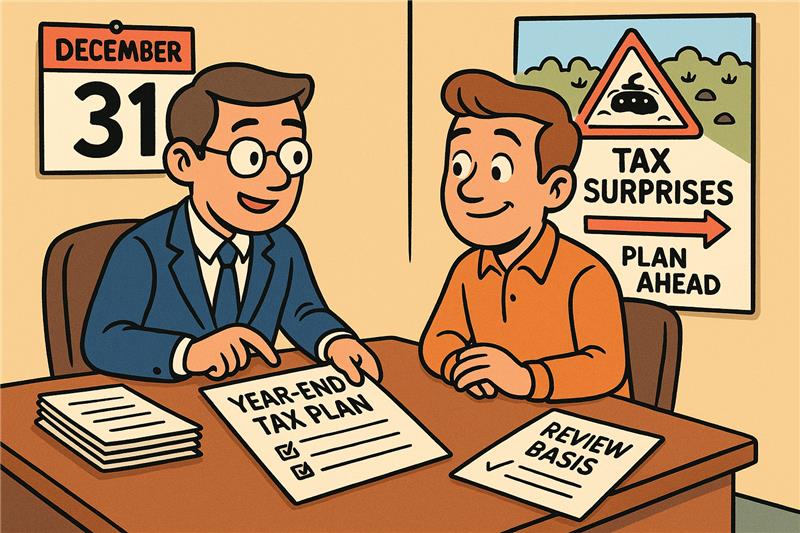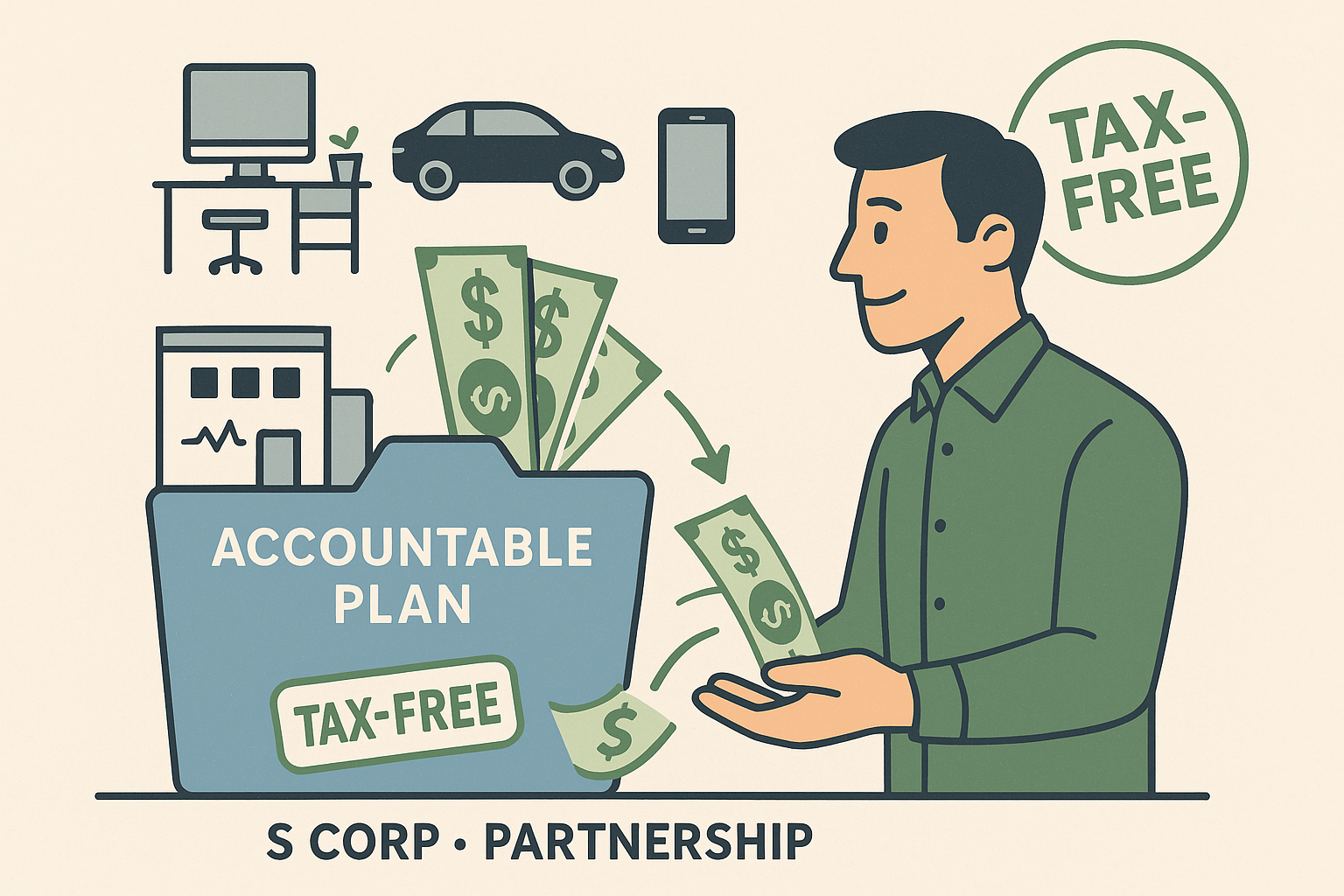Introduction
One of the fastest ways to trigger an unexpected tax bill? Taking what seems like a tax-free distribution—only to learn it exceeded your basis.

Business owners often enjoy the benefit of taking tax-free distributions from their S corporations or partnerships. But that benefit has a ceiling—your basis. Once distributions exceed that limit, the tax-free nature disappears, and capital gains enter the picture. I’ve seen this scenario catch people off guard more than once, and the resulting tax bill is never pleasant. You typically expect to owe tax when you make a bunch of money in a year, but owing tax after a year of losses can be a real kick in the gut.
In this article, we’ll explore exactly what happens when distributions exceed basis, the tax implications, and how to avoid this common (and costly) oversight.
Understanding Basis in S Corporations and Partnerships
Basis, at its core, represents your investment in a business for tax purposes. It’s adjusted annually and determines whether distributions are taxable. For S corporation shareholders, basis begins with the amount paid for stock and is increased by income and additional capital contributions, then reduced by losses and prior distributions.
Partnership basis works similarly, but with one important distinction: partners can receive basis from their share of partnership-level debt, depending on whether it’s recourse or nonrecourse and how risk is allocated. This difference can significantly impact tax outcomes and adds complexity to tracking basis accurately.
Another key distinction is that a basis is not the same as a capital account. Your QuickBooks or K-1 might show a positive capital balance, but if your basis is zero, distributions could still be taxable. Basis is the number the IRS uses to determine if a distribution is taxable—not your books.
What It Means to Distribute More Than Your Basis
When a distribution exceeds your basis, the excess is treated as a taxable gain. Here’s an example:
Suppose you have $5,000 in basis and receive a $10,000 distribution. The first $5,000 is a tax-free return of capital. The remaining $5,000 is taxed as a capital gain. This applies regardless of whether you physically received cash or simply reduced equity.
In S corporations, these excess amounts are generally taxed as long-term capital gains if you’ve held your stock for more than a year. In partnerships, the mechanics can be more nuanced. Your basis could be zero due to prior losses or distributions, but debt basis or other adjustments might still impact the tax treatment.
This is often misunderstood. I’ve seen well-meaning business owners treat distributions as routine draws, not realizing their basis had been fully depleted in prior years. Unfortunately, by the time they discover the issue, it’s too late to undo the tax consequences.
Tax Consequences of Exceeding Basis
For S corporation shareholders, the amount above basis is treated as a gain on the sale of stock—generally reported on Schedule D of the personal return. This happens automatically when distributions exceed stock basis, regardless of whether the business still has cash.
For partners in a partnership, the tax effect is governed by IRC §731. If a distribution exceeds outside basis, the excess is taxable—even if the partner’s capital account appears positive. The IRS doesn’t allow negative basis, so the moment your draw dips below that limit, a gain is triggered.
The risk of audit increases when basis isn’t tracked. The IRS expects shareholders and partners to maintain proper basis documentation—especially S corporation shareholders, who are required to submit a basis worksheet when claiming losses. Failure to do so may result in the IRS treating your basis as zero by default, leaving you to prove otherwise.
How to Track and Manage Basis Effectively
Accurate basis tracking is essential. Unfortunately, many business owners overlook it until it’s too late. To prevent that, use a basis tracking worksheet annually. Tax software can handle this in many cases, but you can also maintain it manually.
Track these items each year:
- Contributions of cash or property
- Allocated income (from the K-1)
- Distributions received
- Losses claimed
- Any relevant loan activity (especially in partnerships)
Be aware that your accountant likely isn’t tracking tax basis if they don’t also do your tax return. Basis adjustments live in the tax world, not the accounting world. So don’t assume that your QuickBooks equity balance reflects your basis—it almost never does.
A best practice is to ask your tax advisor annually: “What is my basis right now?” If they can’t provide that number, it’s worth digging deeper.
Strategies to Avoid Tax Surprises

By far, the most important thing you can do to minimize a surprise from distributions in excess of basis is to do a thorough year-end tax planning with a CPA to ensure you are on the right track. You need to do this planning before the calendar year is up to ensure you have adequate time to address any basis issues.
It’s always tragic when clients choose to skip this vital session in order to save some fees when they end up paying way more in tax than necessary.
Here are a few more practical ways to avoid taxable distributions in excess of basis:
- Review basis before taking distributions. Especially at year-end, run the numbers. It’s better to defer a draw than to create an avoidable capital gain.
- Explore alternatives when basis is low. For S corporations, wages may be a better fit. For partnerships, guaranteed payments may be appropriate.
- Plan for losses strategically. If you anticipate a loss year and your basis is low, consider a capital contribution, or if you’re in a partnership, arrange a basis-increasing loan.
- Track debt basis carefully. Especially in partnerships, where your share of liabilities can significantly affect your usable basis.
- Avoid assumptions. Just because the business has cash doesn’t mean you can withdraw it without tax impact.
It’s important to note a strategy that will not work. Artificially inflating assets with a bogus “Receivable from shareholders” journal entry to pump up basis will get thrown out immediately by the IRS. If you want to increase basis and your entity is a partnership, creating a real recourse loan payable with actual debt terms executed prior to the end of the tax year can help.
In other words, you need to do year-end tax planning to avoid the landmines associated with distributions in excess of basis. A small adjustment in how or when you take money out of your entity can save thousands in surprise tax.
Conclusion
Distributions in excess of basis can create unexpected tax consequences for both S corporation shareholders and partners. The good news is that with a bit of planning and proactive tracking, these surprises are entirely preventable.
Maintaining accurate basis records, consulting your tax advisor before making large withdrawals, and understanding the nuances of entity-specific rules are key steps to protecting yourself from capital gains you didn’t plan for.
If you’re unsure about your basis or need help tracking it, reach out to your CPA—or if you’re looking for a team that lives and breathes this kind of thing, reach out to us here at Elevated Tax and Accounting in Missoula, Montana, would be happy to help.
Disclaimer: This article is for informational purposes only and is not intended as tax, legal, or financial advice. Always consult with a qualified professional about your specific situation. Reading this post does not create a CPA–client relationship.

Joe Holbrook is a CPA and Partner at Elevated Tax & Accounting. Joe’s career has focused on helping business owners pay less tax and improve cash flow, serving companies ranging from small, local businesses, Fortune 500 companies, and everything in between. He also supports nonprofits fulfill their missions through financial excellence, given the highly active nonprofit environment surrounding Elevated’s office in beautiful Missoula, Montana.



